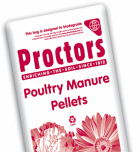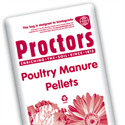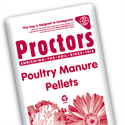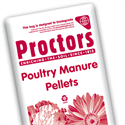Straight and Organic Fertilisers
The list of Proctors fertilisers below are representative of the more popular products we provide to the horticultural market. The benefits of fertilisers, both organic and inorganic, in providing the nourishment plants need is undeniable. Used wisely they encourage strong root systems, healthy leaf growth and abundant flowers and fruit. We hope the information below helps you choose what's best for your plants to help them achieve their full potential.
The fertilisers featured here are a mixture of organic and straight varieties. Straight fertilisers are those which only contain one of the three main nutrients of either nitrogen, potassium or phosphorous as opposed to compound fertilisers which include a blend of these nutrients as well as others secondary and trace elements, such as sulphur, magnesium and calcium.
Organic fertilisers, such as our bone meal and poultry manure options, obtain these nutrients from naturally occurring and sustainable sources. The use of these fertilisers can help the organic grower maximise yield and maintain healthy plants and flowers.
Garden Lime
 |
A very essential product for any keen gardener, Proctors Garden Lime is excellent in increasing ph levels on all soils types where a reduction in soil acidity is required. Very acid soils prevent nutrients being available to the plant, and can greatly reduce productivity, especially around the allotment. Know what ph your crop likes, then test, and lime accordingly. Be sure to lime 6 months apart from nitrogen fertilisers, as they can cancel each other out, and react badly in the soil. Buy Now < Application Rates > |
Sulphate of Ammonia (21-0-0)
 |
100% soluble, this nitrogen fertiliser is fast acting, and can be used where plants are nitrogen deficient. Ideal for green leafed vegetables and producing luxuriant foliage on leafy shrubs, in particular box hedges which are heavy feeders requiring regular treatment, it's the ultimate plant tonic. Can be used every 6-8 weeks during the growing season, but do not over apply. Also often used as a compost activator, as well as a straight for crops. Remember, no lime at this time! Buy Now Application rate:70g sq. m. Dig in well. |
Sulphate of Potash (0-0-50)
 |
Another straight fertiliser, this product is very soluble and fast acting, adding essential Potash to soils and composts. SOP helps improve the quality of fruits and flowers and strengthens plant resistance to disease and inclement weather. Symptoms of Potash deficiency can be poor flowering and fruit sets, as well as the leaves turning yellow around the margins which eventually will become brown and burnt. Severe cases show leaf spotting and scorch of foliage. Buy Now |
Sulphate of Iron +Fe
 |
Iron is a trace element used in many fertilisers, but alone it's used mainly on lawns. It helps with diseases such as fusarium patch and take-all patch which like high ph turf surfaces, as well as helping in worm control. Its most common use though is as a moss killer. Regular applications every 6-8 weeks in the winter months will help stop any moss invading your lawn. It also has the added benefit of burning off certain weeds if used regularly and helps prevent algae problems. Buy Now Application rate:35g sq. m base or dressing or 60g diluted in 10 litres of water to cover 18 sq. m. |
Single Superphosphate (0-18-0)
 |
Made by the action of sulphuric acid on raw rock phosphate (also called Appatite) this is one of the world's most important fertilisers, and probable one of the oldest inorganic ones. Partly soluble and a usable form of phosphorous by plants, it must be well dug in. Ideal for feeding root vegetables such as carrots and beetroot, it also assists in seed germination. Use in soils containing a sufficiency of lime so as not to waste this valuable nutrient through poor plant uptake. Buy Now Application rate:70g sq. m. Dig in well. |
Magnesium Sulphate + MgO + SO4
 |
Also known as Epsom salts, MgO is necessary for the colouring of leaves. Heavy rain will readily wash MgO out of light soils and can also be low when potash or high-potassium fertilisers have been used. MgO deficiency can affect vegetables like cabbages, lettuces and potatoes, fruit such as apples, cherries and grapes. Leaves turn yellow between veins and around the edges, and may eventually turn red, purple or brown. Apply as a foliar spray or spread over the soil. Buy Now Application rate:17g sq. m. Rake in well. |
Hoof & Horn (13.5-0-0)
 |
This 100% organic fertiliser is a by-product of the meat processing industry, and as such may not be for the squeamish. However, it is one of the better organic nitrogen fertilisers, and contains a nice dash of phosphorous to boot. With a slow natural release of nitrogen, some immediately available with the rest continuing to release over 4-5 months, it is perfect for use under glass as well as also being used as an ingredient in other fertilisers such as John Innes Base. Buy Now Application rate:100g sq. m. Dig in well. |
Bone Meal (4-20-0)
 |
A traditional source of nitrogen and phosphate derived from animal waste, it's a popular versatile organic product for use on bulbs, shrubs, planting of trees and as a dressing on vegetables and plots. The nitrogen becomes available over a week or two of microbial action, and the phosphate is almost as available to crops as that of superphosphate. Don't be put off by this product's strong smell, as this gritty powder fertiliser is excellent for all round the garden. Buy Now Application rate:140g sq. m. Dig in well. |
Dried Blood (12-0-0)
 |
You've probably guessed it, another by-product of the meat industry. If you want organic though, then this is one of the most effective organic fertiliser around. Solid rapid release of nitrogen is achieved, despite its low solubility, due to small particle size and easy decomposition after application. Especially beneficial when growing leaf crops such as lettuce, spinach and cabbages, it also makes an excellent top dressing for foliage plants in the green house and conservatory. Buy Now Application rate:100g sq. m. |
Calcified Seaweed Meal
 |
The cycle created by this organic fertiliser is a significant reason for its importance. Quickly colonized by bacteria living in soil, they feed off the huge reservoirs of calcium, nitrogen and phosphorus available in the seaweed, enriching the soil quality. The fertiliser nutrients are also transferred directly to the root structures of plants, making calcified seaweed doubly effective as a fertiliser product. Plants need nutrients beyond calcium, nitrogen and phosphorous, such as iron and carbon, and with additional trace elements, calcified seaweed can provide it all. Notable for its flexibility, calcified seaweed not only regulates the ph. of your soil, but it can also be used throughout the calendar year. Buy Now Application rate:75g sq. m. |
Poultry Manure Pelletts
 |
Used as a non-chemical fertiliser, poultry manure pellets vary in analysis, but typically contain 3% Nitrogen, 2% Phosphate, and 2% Potash, as well as trace elements. Buy Now Flowers and Vegetables: prior to sowing or planting, 180g/sq m As top dressing for established plants: 120g/sq m Shrubs and Trees: as a top dressing in spring, 180 – 240g/sq m applied evenly over the area covered by the branch spread. |






















